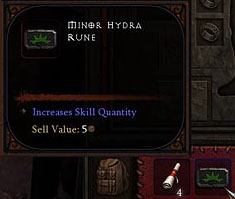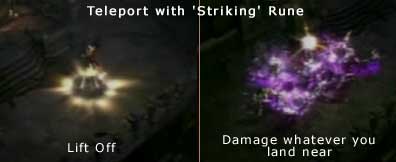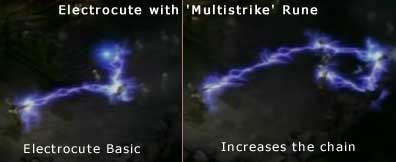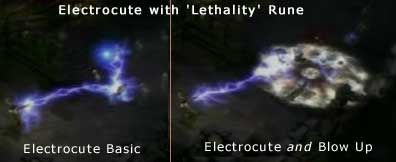Skill Runes
Runes in Diablo 3 are small items that are socketed into active skills, (not into items as they were in Diablo 2). Diablo 3's skill runes grant special bonuses to the skill they are socketed into, improving the skill's function in various ways, such as adding damage or multiple hits, reducing cost, etc.
There are five types of runes, each representing a general type of bonus, the names of which have changed repeatedly during game development. The final name change was revealed in May 2010, when Bashiok [1] revealed the names as having changed to Crimson, Indigo, Obsidian, Golden, and Alabaster. Considerable, but not total, changes to their bonuses came with that name change.
Runes spawn at various levels of quality (5 or 6 levels), e.g., "Minor Alabaster Runestone."
Contents
Every Rune Works in Every Skill
Jay Wilson has stressed that runes must add a useful function to multiple types of skills, since every type of rune will be socketable in every action skill. (As far as we know.) This leads to some odd and creative design decisions, since while it's obvious what most runes will do in most skills, there are some exceptions. Consider what a rune that adds multiple hits or damage does for a purely defensive/shielding skill? Or a movement skill like the Wizard's Teleport?
The D3 Team wants all the runes to be useful to all classes, so they did not add runes that just boosted one type of skill, or one character's skills. They had to find general function bonuses that worked across the board, which is why there are not fifty types of runes. Instead there are just five rune types, though even with just 5, their functions change quite a bit from skill to skill, in many cases.
Rune Types and Functions
There have been five types of runes ever since they were announced as a game feature. The names and functions of the five types have changed repeatedly though, and the team is certain to continue modifying them throughout the remainder of the development process.
Though the five types of runes kept changing names, but their functions seemed to be largely set all through 2009 and into 2010. This apparent certainty was overturned by new info[2] from Jay Wilson at the Gamescom show in August 2010.
Rune Tool Tips
The team has stressed that every rune will have an informative tool tip, letting players know approximately what that rune will do in a given skill. To see this in the game, players need pick up a rune and then hover it over a skill with a socket. [3]
- Pick up a rune and mousing it over a skill and the tooltip will tell you how it affects the skill. The UI does a good job of informing you how each rune interacts with each skill.
Original Rune Functions
Jay Wilson described the five types of runes during an interview from BlizzCon 2009. The quoted sections below are Jay's words: [4]
- The Power Rune, which was renamed Force Rune: "One tends to be more damage-oriented."
- The Multistrike Rune, which was renamed the Hydra Rune: "One tends to multiply effects, splits projectiles or bigger radiuses, things like that."
- The Energy Rune: "One tends to be a very energy-efficient rune, so you cut down cost or in some way increases the benefit of the skill, so you get more for less."
- The Lethality Rune, which was renamed Viper: "One tends to be more focused on death effects, critical effects."
- The Striking rune: "And one of them we call just... the weird rune, which is our grab bag for anything unusual we want to stick on."
Though all the names have changed, three of the functions remain largely intact. Most skills still benefit from a +damage rune, a multishot/strike rune, and a critical hit boosting rune. The wildcard rune is still very wild. The biggest change is that the former Energy rune is largely changed to a second wildcard rune, since changes to the resource systems made its former function largely obsolete.
Hydra: The First Example
Jay didn't describe the full rune system at Gamescom, but he gave examples of what the various Runes do with the Wizard skill Hydra, which shows off the big changes to the skill from runestones. [5]
- Jay Wilson: One of my favorites is on the Wizard. She has a skill called Hydra, which is largely the same as it was in Diablo 2. Fiery (dragon) heads that shoot fireballs. Depending on which rune the Wizard sockets in that skill, the dragon heads change elements, and it’s a major change. Their entire appearance is altered. They can become poison heads, which shoot bolts of poison that leave pools of acid on the ground. There are lightning heads that shoot Chain Lightning. Cold heads that shoot Frost Bolts that slow enemies. Another rune makes for a bigger fire attack, where the head just breaths a cone of flame.
Jay did not list what all five runes did in Hydra, and his explanation left fans confused. Where were the three elemental damage types coming from? Nothing like that seemed to fit wit the previous rune functions.
Rune Changes Explained
Diablo III Community Manager Bashiok spoke to Diii.net about runestones shortly after Gamescom, in August 2010, and explained a lot of the lingering questions from Jay's Gamescom update. [6]
In Hydra, five runes provide: extra damage (with a changed fire form), Multistrike (rapid fire), and the 3 elemental properties. Extra damage and multishot are consistent with previously known rune functions. One of the elementals comes from the wildcard rune, and the other comes from what used to be the Energy rune. That rune now functions as a second wildcard in most skills, since changes to the resources made the mana-saving property obsolete. (Plus it just wasn't cool enough, in most instances.)
So Hydra isn't a total outlier; it's just got one rune, (formerly known as Lethality) that usually affects critical bonuses, that's doing something very different (providing an elemental damage change, in Hydra).
Many of the skills in the game have undergone similar transformations, in terms of their Runestone effects. The D3 Team has gone over all of them, more than 600 (20-25 skills per char x 5 chars x 5 runes) and tried to make them all "awesome." Visual, interesting, exciting; not just stat-tweaking. This is a huge project, with a lot of trial and error, and it's ongoing.
The changes to artwork and graphics are extensive, but they can usually adapt other art elements from the game, rather than having to make new effects from scratch. For instance, a new runestone change to the Witch Doctor's Corpse Spiders spell caused a huge "mother spider" to spawn, instead of just tiny spiders. The artists were able to create this by modifying an existing spider model. They put on a new texture, changed the size, tweaked the AI, and voila, they've got a big spider that fits perfectly with the new runestone effect.
The biggest problem seems to be balancing. How can they even out the effects and utility of so many runes doing so many different things? Bashiok admitted that was a challenge, but said that perfect balance wasn't required. As long as none of the rune properties were wildly over or underpowered, it would be find for PvE play. They might have to do more fine-tuning when it came to PvP though, since there it really does matter if one skill is slightly better than another. But they're not to the point of worrying much about that, yet.
Rune Names
There are five types of runes in Diablo 3. Their names have changed during development, though when he named them in (May 2010), Bashiok said these were fairly set for the final game: Crimson, Indigo, Obsidian, Golden, Alabaster. The team refers to these as "substance/mineral" names.
- Energy Rune, new name unknown.
- Viper Rune, previously the Lethality Rune. New name unknown.
- Hydra Rune, previously the Multistrike Rune. Now the Indigo Rune.
- Force Rune, previously the Power Rune. New name unknown.
- Striking Rune, new name unknown.
Rune Name Evolution
Blizzard's Diablo 3 community manager shed some light on the reason for the latest rune name change in May 2010: [7]
- Bashiok: The runes have really just been renamed to allow us greater flexibility in what they do so we’re not creating a weird detachment from what they’re called and the effect they provide. For example what was the multi-strike rune going to do for ... say, Slow Time? And does that match what the name implies, or what you would assume? Probably not.
A few days later, he elaborated on this issue:
- Bashiok: ...the purpose of renaming them was... to remove a strict theme. I’m not aware of any rune effects we’ve shown being removed, I think all those still exist just the way they were shown. Just instead of multi-strike/hydra, it’s called Indigo, and while for a lot of skills it still has a very multi-strike theme, it’s not a rule dictated by the name.
Rune Quality Levels
There are five types of runes. Each individual rune, of whatever type, can spawn at various quality levels; Jay Wilson said there would be five or six such levels. As of late 2008, "minor" was said to be the lowest quality, though the modifier names may have changed since that point. As with all items in the game, higher quality runes will be rarer, and only findable from higher level monsters. The functions of a given type of rune will not change as the quality increases; instead the bonuses will be increased.
The name format is fairly simple, as Bashiok described in May 2010. [8]
- I don’t think quality names have been decided for sure yet (?), but for example it would be something like “Minor Alabaster Runestone”.
- For example: "[quality] [rune type] Runestone"
Rune Crafting/Upgrading
The D3 team has confirmed that the Mystic will have some crafting recipes to create new runes, though there are no details yet, other than that they will use old Runes in the process.
It will also be possible to salvage unwanted runes for magical materials,
Rune Storage
At the BlizzCon 2008 demo, runes were stored in an inventory grid on the skill tree menu; not in the normal inventory.
They are now stored in the main inventory, and like runes should stack, to save on inventory space.
Rune Appearance
As of BlizzCast episode 8 (30th of March, 2009) [9] Runes and Rune Sockets were horizontal rectangles, as seen in the image to the right. Previously, runes and their sockets had been square-shaped.
A more recent image, from August 2010, is seen to the left. Runes are now round, like marbles, and bear striking glyph graphics. In light of this change, it's assumed that the sockets in skills are now round as well.
Rune Function Examples
The D3 Team gave several examples of rune functions during a panel at BlizzCon 2008 when Skill Runes were first revealed as a game feature. (Watch the demonstration on YouTube.) The rune names have all changed since this time, but the illustrated functions are said to be largely unchanged.
Wizard's Mirror Image
Mirror Image Skill: This skill, from the Conjuring Skill Tree, creates a duplicate of the wizard, which is capable of moving around and using spells to attack monsters. (It's not just a decoy or an illusion.)
- Hydra/Multistrike Rune: Socketing this rune would increase the number of duplicates. Higher quality levels of the hydra/multi-strike rune would presumably add more duplicates.
- Force/Power Rune: Socketing this rune would increase the hit points of each duplicate, and increase the spell's duration.
Wizard's Teleport Skill
Teleport skill: This skill, from the Arcane Skill Tree, teleports the Wizard to the targeted location. The spell isn't quite as quick as it was in Diablo or Diablo 2, since the Wizard leaps up into the air before vanishing, and appears in the air, then falls down to earth.
- Striking Rune: Adds damage to targets near where the Wizard appears, functioning something like the Barbarian's Leap Attack skill.
- Hydra/Multistrike Rune: Creates a temporary duplicate of the Wizard that will attract enemy fire and will fight and deal damage as well. (This seems to be basically a free way to cast Mirror Image when you Teleport.)
Witch Doctor's Skull of Flame
Skull of Flame skill: The Witch Doctor lobs a flaming skull, grenade style, which explodes on impact, dealing substantial fire damage to nearby targets. Different runes affect this skill in different ways. Here are a couple of examples as presented during a BlizzCon 2008 panel discussion.
- Hydra/Multistrike Rune: Socketing this rune causes the flaming skull to skip along the ground, like a stone over water, bounding and creating multiple explosions. Higher quality runes would allow additional bounces.
- With Force/Power Rune: Socketing this rune adds a firefield property to the Skull of Flame, creating a small patch of flame on the ground that persists after the skull's explosion and damages any monsters that cross over it.
Wizard's Electrocute
Electrocute skill: This skill, from the Storm Skill Tree creates a strand of lightning that locks onto an enemy like a beam weapon, dealing steady lightning damage.
- Hydra/Multistrike Rune: Socketing this rune allows the lightning to chain to multiple targets.
- With Viper/Lethality Rune: Socketing this rune causes some of the monsters killed by Electrocute to explode in a nova, dealing damage to other nearby enemies.
D3 Runes vs. D2 Runes
Runes in Diablo III are nothing like the Runes found in Diablo II. In D2 there were 33 kinds of Runes, which were small items that had no use on their own, but that could be placed in item sockets to add various bonuses to the item. Certain combinations of runes could also be used to create RuneWords, very powerful items with pre-set stats.
BlizzCon 2009
Skill Runes were not enabled at BlizzCon 2009, for reasons Jay Wilson elaborated on during an interview after the show:
- Diii.net: They’re still being reworked and you don’t have any further comment?
- Jay Wilson: They’re not being reworked, we had tons of skill runes on the Wizard and the Barbarian but they were so spotty across the entire class we thought it would be more confusing to show them off than to not. So we just disabled them all for the BlizzCon build. But they’re all still there and they work just fine.
During another interview, Jay Wilson explained the creative process of making a rune, and how making any changes at all to the first steps will scrap the end results entirely, as can be seen in the image on the right. [10]
- Jay Wilson: Well, the system is similar for every class. What we did is we broke down five basic runes. Each rune has a general type of effective pluses. One tends to be more damage-oriented. One tends to multiply effects, splits projectiles or bigger radiuses, things like that. One tends to be a very energy-efficient rune, so you cut down cost or in some way increases the benefit of the skill, so you get more for less. One tends to be more focused on death effects, critical effects. And one of them we call just... the weird rune, which is our grab bag for anything unusual we want to stick on.
- Every active skill -- we define an active skill as a skill that you have to click to activate -- can have all five runes affect it. Each rune will change the function of the skill. Some of the changes are minor, there are some cases where there's not much appreciable effect. And then some cases are much more drastic, where for example with Ice Storm or Blizzard, one of the things we're playing around with, this halo of frost whips around her and anyone that moves through it takes damage. That adds on to the effects that Ice Storm already does. So there's a whole bunch of different... the basic idea is to capture that dream of, I'm gonna customize my skills. Even though you and I have the exact same skills, we don't play the same because our skills are different. And then throughout the game, the runes will upgrade in power. So that will just increase and amplify the effect that they have.
Further Reading
You can find out more of the essential information about Diablo I and Diablo II runes in the Diablo 2 Wiki.
Diablo II Runes
- Runes - The main page for D2 runes.
- Rune FAQ - All your questions about runes are answered here.
- Rune list - All the runes in Diablo II, and how you can create a Zod rune from a fourteen trillion Els.
- Runewords - See how runewords work.
- Sockets - Get to know more about the socket mechanic.
Diablo I Runes
The Diablo I expansion, Hellfire added "runes" as a trap-like type of item. Read more about them in the Diablo I Runes article.
Trivia (Rune History)
What do you really know about runes? The ones from our world come from the ancient Vikings, and their "futhark" (equivalence of our 'Alpha Bet(a)') (which again come from the even more ancient Tibetan Yantras). They allegedly hold magic powers, and the magicks of the 'runa' are still practised today. These practices, called "Seden", are of course done mostly as a pastime, but some forms of the old runes were used in proper form as late as early 20th century in the 'Dalarna' area of Sweden...
In Sanctuary, however, runes are magically inscribed symbols. Though their use has changed slightly in the last 20 years, they used to grant (sufficiently prepared) items magical properties. For sages of these runes, magical RuneWords would be created to remake a mundane item into a Runic Item, with powers competing with magical artifacts.
Besides the fact that these supposedly ancient runes hold great and mystic powers, we know little about them. Who created them or how they are created is unknown. They seem to attract demons of different kinds, as they are often found on their corpses. If the runes are of demonic origin is not known either. They could have been the simple writing language of the first inhabitants of Sanctuary, who themselves were more powerful than Demons or Angels. Whatever the origin, they are of great use to heroes wishing to dethrone Diablo or Baal.









